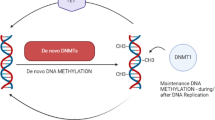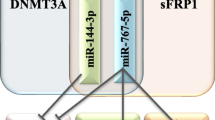Abstract
Methylation of promoter regions of CpG-rich sites is an important mechanism for silencing of tumor suppressor genes (TSG). To evaluate the role of tumor suppressor genes caspase-8 (CASP8), TIMP-3, E-cadherin (CDH1), p16INK4A, and MGMT in medulloblastoma tumorigenesis, 51 medulloblastomas (46 primary tumor specimens, 5 cell lines) were screened for methylation of promoter linked CpG-islands. For CASP8, we examined the 5′ UTR region that has been shown to be associated with expression of CASP8. As detected by methylation specific PCR, methylation rate was low for TIMP-3 (3% of tumor samples; 1/5 cell lines), for MGMT (0% of tumor samples; 1/5 cell lines), for p16INK4A (2% of tumor samples; 2/5 cell lines) and for CDH1 (8% of tumor samples; 1/4 cell lines). CASP8, however, was methylated in 90% of tumor samples and 4/5 cell lines examined. Screening other tumor entities for CASP8 methylation, we found a similarly high level in 6 neuroblastoma cell lines in contrast to 5 osteosarcoma-, 4 Ewing’s sarcoma-and 6 non-embryonic tumor cell lines without any increased promoter methylation. From our results we conclude that methylation of the CASP8 5′ UTR region may play a role in inactivation of CASP8 in neural crest tumors.
Similar content being viewed by others
Abbreviations
- CASP8:
-
caspase-8
- MGMT:
-
O6-methylguanine-DNA-methyl-transferase
- PNET:
-
primitive neuroectodermal tumor
- TIMP-3:
-
tissue inhibitor of met alloproteinase 3
- TRAIL:
-
TNF-related apoptosis inducing ligand
- TSG:
-
tumor suppressor gene
- UTR:
-
untranslated region
References
Bachman KE, Herman JG, Corn PG et al: Methylation-associated silencing of the tissue inhibitor of metalloproteinase-3 gene suggests a suppressor role in kidney, brain, and other human cancers. Cancer Res 59: 798–802, 1999.
Banelli B, Casciano I, Croce M et al: Expression and methylation of CASP8 in neuroblastoma: identification of a promoter region. Nat Med 8: 1333–1335; author25 reply 1335, 2002.
Barker FG, Chen P, Furman F et al: P16 deletion and mutation analysis in human brain tumors. J Neurooncol 31: 17–23, 1997.
Berx G, Staes K, van Hengel J et al: Cloning and characterization of the human invasion suppressor gene E-cadherin (CDH1). Genomics 26: 281–289, 1995.
Bobola MS, Berger MS, Ellenbogen RG et al: O6-methylguanine-DNA methyltransferase in pediatric primary brain tumors: relation to patient and tumor characteristics. Clin Cancer Res 7: 613–619, 2001.
Bodmer JL, Holler N, Reynard S et al: TRAIL receptor-2 signals apoptosis through FADD and caspase-8. Nat Cell Biol 2: 241–243, 2000.
Costello JF, Frühwald MC, Smiraglia DJ et al: Aberrant CpGisland methylation has non-random and tumor-type-specific patterns. Nat Genet 25: 132–138, 2000
Esteller M, Sanchez-Cespedes M, Rosell R et al: Detection of aberrant promoter hypermethylation of tumor suppressor genes in serum DNA from non-small cell lung cancer patients. Cancer Res 59: 67–70, 1999.
Esteller M, Garcia-Foncillas J, Andion E et al: Inactivation of the DNA-repair gene MGMT and the clinical response of gliomas to alkylating agents. N Engl J Med 343: 1350–1354, 2000.
Friesen C, Herr I, Krammer PH, Debatin KM: Involvement of the CD95 (APO-1/FAS) receptor/ligand system in druginduced apoptosis in leukemia cells. Nat Med 2: 574–577, 1996.
Frühwald MC, O’Dorisio MS, Dai Z et al: Aberrant promoter methylation of previously unidentified target genes is a common abnormality in medulloblastomas-implications for tumor biology and potential clinical utility. Oncogene 36: 5033–5042, 2001.
Fulda S, Sieverts H, Friesen C et al: The CD95 (APO-1/Fas) system mediates drug-induced apoptosis in neuroblastoma cells. Cancer Res 57: 3823–3829, 1997.
Fulda S, Debatin KM: IFN sensitizes for apoptosis by upregulating caspase-8 expression through the STAT1 pathway. Oncogene 15: 2295–2308, 2002.
Grenet J, Teitz T, Wei T et al: Structure and chromosome localization of the human CASP8 gene. Gene 226: 225–232, 1999.
Grotzer MA, Eggert A, Zuzak TJ et al: Resistance to TRAILinduced apoptosis in primitive neuroectodermal brain tumor cells correlates with a loss of caspase-8 expression. Oncogene 19: 4604–4610, 2000.
Harada K, Toyooka S, Shivapurkar N et al: Deregulation of caspase 8 and 10 expression in pediatric tumors and cell lines. Cancer Res 62: 5897–5901, 2002.
Herman JG, Graff JR, Myohanen S et al: Methylation-specific PCR: a novel PCR assay for methylation status of CpG islands. Proc Natl Acad Sci USA 93: 9821–9826, 1996.
Jones PA, Baylin SB: The fundamental role of epigenetic events in cancer. Nat Rev Genet 3: 415–428, 2002.
Katzenellenbogen RA, Baylin SB, Herman JG: Hypermethylation of the DAP-kinase CpG island is a common alteration in B-cell malignancies. Blood 93: 4347–4353, 1999.
Mannello F, Gazzanelli G: Tissue inhibitors of met alloproteinases and programmed cell death: conundrums, controversies and potential implications. Apoptosis 6: 479–482, 2001.
Miller SA, Dykes DD, Polesky HF: A simple salting out procedure for extracting DNA from human nucleated cells. Nucl Acid Res 16: 1215, 1988.
Packer RJ: Childhood medulloblastoma: progress and future challenges. Brain Dev 21: 75–81, 1999.
Ramchandani S, MacLeod AR, Pinard M et al: Inhibition of tumorigenesis by a cytosine-DNA, methyltransferase, antisense oligodeoxynucleotide. Proc Natl Acad Sci USA 94: 684–689, 1997.
Schutz BR, Scheurlen W, Krauss J et al: Mapping of chromosomal gains and losses in primitive neuroectodermal tumors by comparative genomic hybridization. Genes Chromosomes Cancer 16: 196–203, 1996.
Teitz T, Wei T, Valentine MB et al: Caspase-8 is deleted or silenced preferentially in childhood neuroblastomas with amplification of MYCN. Nat Med 6: 529–535, 2000.
Zöchbauer-Müller S, Fong KM, Virmani AK et al: Aberrant promoter methylation of multiple genes in non-small cell lung cancers. Cancer Res 61: 249–255, 2001.
Zuzak TJ, Steinhoff DF, Sutton LN et al: Loss of caspase-8 mRNA expression is common in childhood primitive neuroectodermal brain tumour/medulloblastoma. Eur J Cancer 38: 83–91, 2002.
Author information
Authors and Affiliations
Corresponding author
Rights and permissions
About this article
Cite this article
Ebinger, M., Senf, L., Wachowski, O. et al. Promoter methylation pattern of caspase-8, P16INK4A, MGMT, TIMP-3, and E-cadherin in medulloblastoma. Pathol. Oncol. Res. 10, 17–21 (2004). https://doi.org/10.1007/BF02893403
Received:
Accepted:
Issue Date:
DOI: https://doi.org/10.1007/BF02893403




